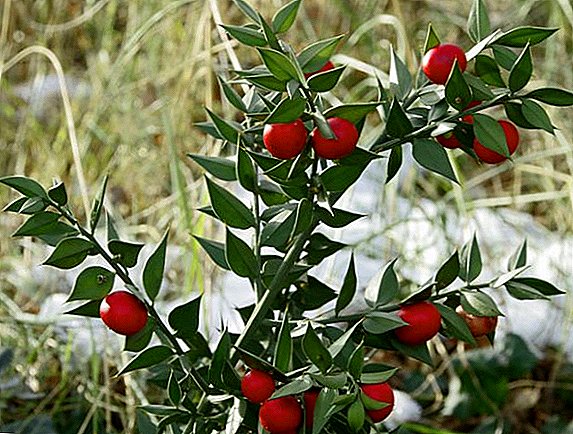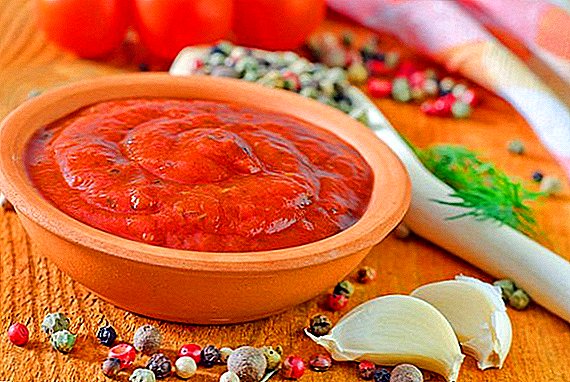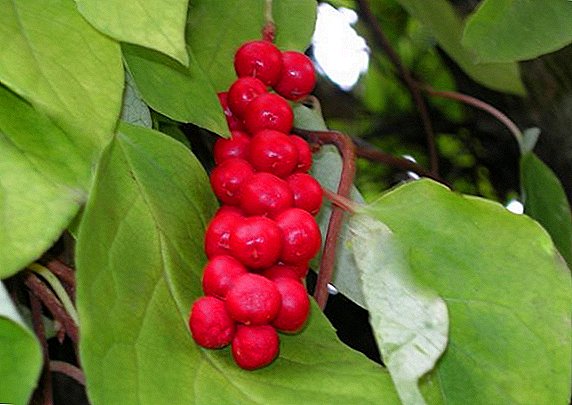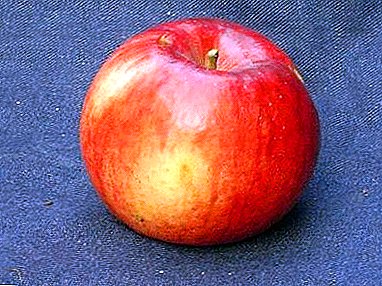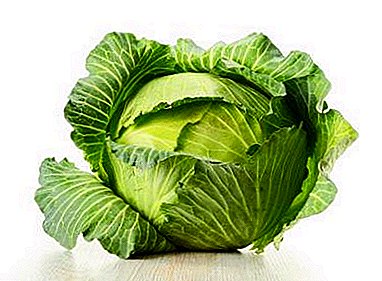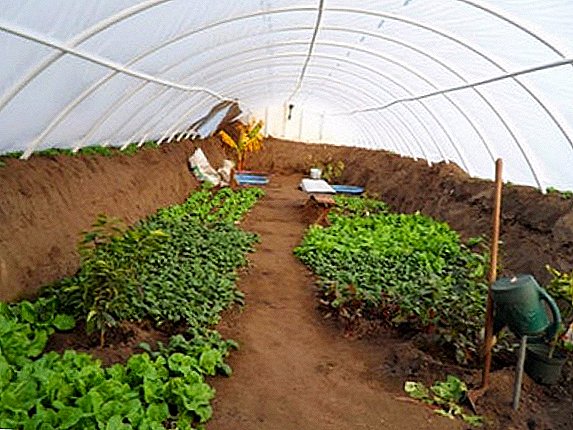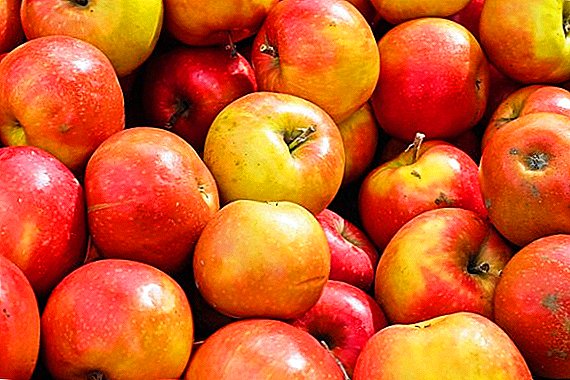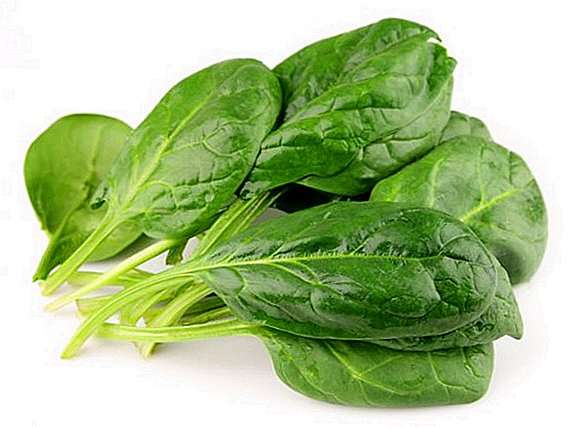 Spinach - vegetable crop containing many easily digestible vitamins, organic and fatty acids, micro and macro elements necessary for a healthy diet. These greens are useful and desirable on every table. Regular consumption of spinach is an excellent prevention of diseases of the digestive, nervous, cardiac systems, metabolic disorders, well boosts immunity.
Spinach - vegetable crop containing many easily digestible vitamins, organic and fatty acids, micro and macro elements necessary for a healthy diet. These greens are useful and desirable on every table. Regular consumption of spinach is an excellent prevention of diseases of the digestive, nervous, cardiac systems, metabolic disorders, well boosts immunity.
Did you know? Spinach leaves contain vitamins K, E, PP, C, P, A, B2, B6, manganese, silicon, iron, cobalt, waist, boron, chromium, iodine, calcium, rubidium, zinc, vanadium. As well as serotonin, phytosterols, polysaccharides, omega-3-polyunsaturated fatty, ascorbic and oxalic acids.
When sow spinach
Growing spinach in the open field can start from the beginning or mid-April, focusing on the steady weather. Spinach - cold resistant, air temperature of + 4-5 ° С is quite suitable for seeding, and its shoots can withstand frosts down to -5-6 ° С.
How to get an early spinach harvest
 Spring planting spinach gives a later harvest - around mid-June, not earlier. Is it possible and when it is planted to put spinach in open ground for an earlier harvest? Can. Do it in regions with mild winters or sow winter crops in late August - early September.
Spring planting spinach gives a later harvest - around mid-June, not earlier. Is it possible and when it is planted to put spinach in open ground for an earlier harvest? Can. Do it in regions with mild winters or sow winter crops in late August - early September.
Planting spinach before winter, get the first greens in April. In this method, during the time from sowing to the first shoots, in 14-16 days spinach takes root and hibernates well. And with the warming in March, it is rapidly growing.
Important! After collecting the early harvest in 45-50 days, you can again collect greens from the bushes a second time, and the plants are completely removed.
Spinach Soil Requirements
Neutral, loamy and sandy, rich in organic soil is best suited for growing spinach. In addition, the soil for spinach should not be too acidic - the pH is not higher than 7.
Good precursors for this plant are potatoes, cucumbers, legumes, cabbage, tomatoes.
Did you know? Spinach food processing - cooking, frying, stewing, canning, freezing - slightly change its composition, it retains its useful biologically active elements.
Soil preparation for planting
 The soil for spinach is prepared in the fall - they feed and dig. Digging depth - 25 cm. Spinach fertilizer is recommended to carry out potash-phosphate preparations, humus, compost. The approximate number of components per 1 square. m - 5 g of phosphorus, 8 g of nitrogen, 10 g of potassium, 5.5-6 kg of humus.
The soil for spinach is prepared in the fall - they feed and dig. Digging depth - 25 cm. Spinach fertilizer is recommended to carry out potash-phosphate preparations, humus, compost. The approximate number of components per 1 square. m - 5 g of phosphorus, 8 g of nitrogen, 10 g of potassium, 5.5-6 kg of humus.
Important! Nitrogen is used as fertilizer only in autumn, not in spring. Spinach quickly accumulates its excess, which is harmful to human health.
Sowing spinach seeds in open ground
Growing spinach seeds directly into the ground without sprouting seedlings used quite often. To do this, before sowing seeds are soaked for 20-24 hours. When soaking, the pericarp (shell) of the seed serves as a guide: if it has softened from the water, the seeds are ready for planting.
 Before sowing, the seeds are slightly dried - laid out on a dry towel so that excess moisture is absorbed and no seeds are clumped. Manure seeds (potassium permanganate) can be added to the water for irrigation, so that a weak disinfectant solution is obtained. The seeding depth is 2-2.5 cm, the distances between the beds, if they are somewhat parallel, are 20-25 cm.
Before sowing, the seeds are slightly dried - laid out on a dry towel so that excess moisture is absorbed and no seeds are clumped. Manure seeds (potassium permanganate) can be added to the water for irrigation, so that a weak disinfectant solution is obtained. The seeding depth is 2-2.5 cm, the distances between the beds, if they are somewhat parallel, are 20-25 cm.
Important! Spinach is contraindicated in diseases of the duodenum, kidney, liver, gallbladder. With care it is introduced into baby food. This is due to the increased content of oxalic acid in vegetables.
Spinach crop care
Spinach is photophilous, but also grows well in partial shade, that is, it can be planted as a separate section from other crops, and using it as a separator between different garden plants. At the same time spinach is unpretentious, and care for it consists in timely watering, loosening the soil, thinning, weeding.
 Water it moderately until the sprouts germinate - from a watering can with a spray when it takes root - watering is sufficient, but moderate. Seedlings thin out at the appearance of the second leaf, leaving a distance between them of 15-20 cm. Loosening is done every time as the soil dries. How to water spinach in dry summer?
Water it moderately until the sprouts germinate - from a watering can with a spray when it takes root - watering is sufficient, but moderate. Seedlings thin out at the appearance of the second leaf, leaving a distance between them of 15-20 cm. Loosening is done every time as the soil dries. How to water spinach in dry summer?
Water more often and more abundant, but make sure that the water does not stagnate and there is good aeration. Excess moisture will lead to the formation of powdery mildew and other spinach diseases. During prolonged rainy weather, it is better to stretch the film on the pegs above the beds to avoid excessive moisture. As a rule, the soil for spinach is fertilized before planting - in the fall and, if necessary, in the spring before sowing, therefore, in the vegetation phase, spinach fertilizer is not carried out.
Harvest
 Harvesting spinach can be started when the plant has six leaves developed, mostly it is done with the development of 8-10 leaves. Cut the stem under the first leaf. The roots of spinach spring planting dig. You can immediately pull out the entire plant instead of cutting. To tighten the collection of greens can not be - the leaves outgrow, become coarse, lose taste. Do not harvest after watering or rain. The best time for harvesting is early morning, then the leaves will be fresh and not wrinkled.
Harvesting spinach can be started when the plant has six leaves developed, mostly it is done with the development of 8-10 leaves. Cut the stem under the first leaf. The roots of spinach spring planting dig. You can immediately pull out the entire plant instead of cutting. To tighten the collection of greens can not be - the leaves outgrow, become coarse, lose taste. Do not harvest after watering or rain. The best time for harvesting is early morning, then the leaves will be fresh and not wrinkled.
Did you know? In spinach planted in spring and summer, leaves are smaller and lighter, and those planted in autumn have larger and dark green leaves.
Diseases and pests of spinach, how to deal with them
All gardeners need to know how to grow spinach in the country or garden and avoid damage by pests. It is better to carry out prevention of the disease in advance, adhering to agrotechnical techniques: follow the rules of crop rotation and watering, eliminate weeds, plant varieties resistant to pests. The main pests of spinach are the larvae of miners and beet flies, which gnaw holes in the foliage, slugs, aphids, babuha beetles, rotten diseases of leaves and roots, downy mildew, scoop-gama caterpillars and cabbage scoops.
All diseases begin due to violation of the rules of agricultural engineering. It is not recommended to treat and spray chemicals with spinach. When the lesions are in the easy stage, you can apply pepper, tomato, tobacco solutions for spraying. If you can not cope with pests, the affected plants are destroyed.


